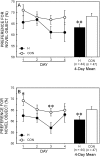Object recognition memory and the rodent hippocampus
- PMID: 20028732
- PMCID: PMC2807177
- DOI: 10.1101/lm.1650110
Object recognition memory and the rodent hippocampus
Abstract
In rodents, the novel object recognition task (NOR) has become a benchmark task for assessing recognition memory. Yet, despite its widespread use, a consensus has not developed about which brain structures are important for task performance. We assessed both the anterograde and retrograde effects of hippocampal lesions on performance in the NOR task. Rats received 12 5-min exposures to two identical objects and then received either bilateral lesions of the hippocampus or sham surgery 1 d, 4 wk, or 8 wk after the final exposure. On a retention test 2 wk after surgery, the 1-d and 4-wk hippocampal lesion groups exhibited impaired object recognition memory. In contrast, the 8-wk hippocampal lesion group performed similarly to controls, and both groups exhibited a preference for the novel object. These same rats were then given four postoperative tests using unique object pairs and a 3-h delay between the exposure phase and the test phase. Hippocampal lesions produced moderate and reliable memory impairment. The results suggest that the hippocampus is important for object recognition memory.
Figures




References
-
- Albasser MM, Davies M, Futter JE, Aggleton JP. Magnitude of object recognition deficit associated with perirhinal cortex damage in rats: Effects of varying the lesion extent and the duration of the sample period. Behav Neurosci. 2009;123:115–124. - PubMed
Publication types
MeSH terms
Grants and funding
LinkOut - more resources
Full Text Sources
Other Literature Sources
Medical
